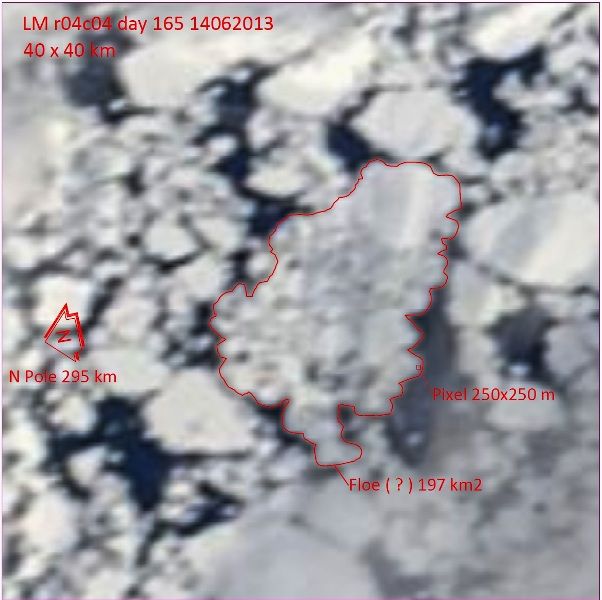Just as a ‘sidekick’ from what I’ve been doing on MODIS Beaufort Sea this morning, I thought to compare the shot I made 14 June of part of tile r04c04:
This was 14 June:

Now it is like this:

An image speaks for itself…
As for the Beaufort Sea:
Took a part of about 7200 km2 in what was open sea day 184 last year. Centered about 130 km W of the SW tip of Banks Island. I fished up 185 MYI floes (at least, they stand out from the lower albedo mélange). Their average area was less than 11 km2.
I think a big difference with last year in the Beaufort Sea is, that the February fragmentation/rotation events pushed this MYI in from the CAB while dispersing them.
Mind that the arbitrary boundary BS – CAB lies in front of the Mc Clure Strait, 300 km N of my count area.
Another aspect is, that all these MYI floes (same process spanning a zonal band from Banks to N of Barrow) belonged to the 1,8 Mkm2 remaining structural unity of the mesh-pack against the CAA. This dispersal means loss for that area.
Continuing the count; underlining the structural weakness of the Beaufort Sea ice cover are more than 150 open water polynia’s worth digitizing. Together, they don’t seem like much (less than 1% of the count area). But they represent the parts showing the most albedo loss. And while even the MYI floes are covered with wet snow/melt ponds (they show up as gray shades), it shows something…
What then, please?
See, the Beaufort Sea area is about 580K km2. Last year, about 300 K was open, this year about 100K.
The difference isn’t good, solid, countable area and extent ice. It is a mélange heading for melt out. The MYI floes, about 30% from 480K when I extrapolate the count zone,
will last, maybe even until refreeze, that makes 174K.
The rest, rubble/floes smaller than 1,5 km2 isn’t a solid plate. It is broken up, forming pressure ridges (visible even on MODIS) and sloshing through winds and tide. It covers 72% of the count area. That goes for 345,6K (extra above the present 100K) melting out in the Beaufort Sea before the end of this season.
Thanks for remaining with me, I’ll try to fit this in an image later.
